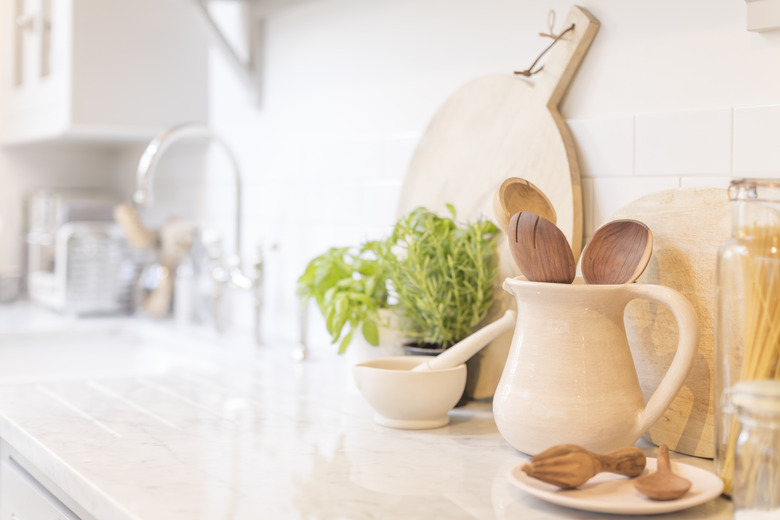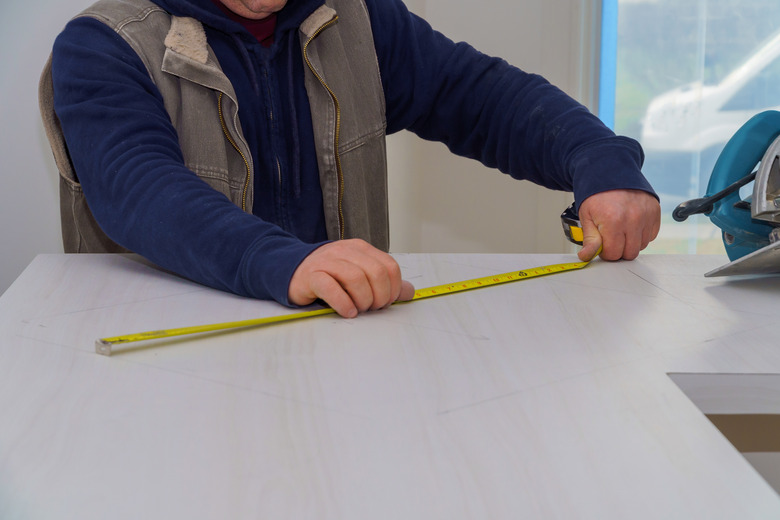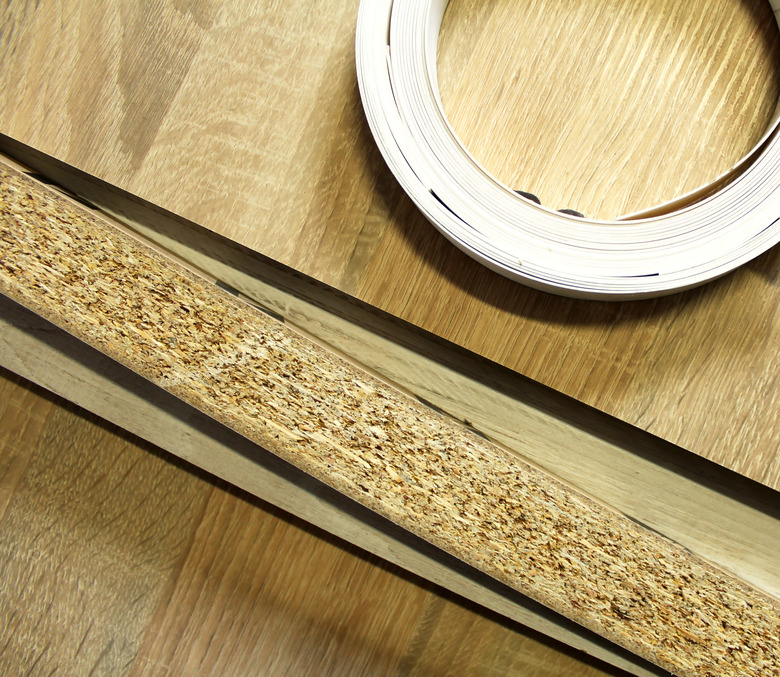What Is Countertop Resurfacing?
The options for countertop resurfacing are nearly as plentiful as the options for buying a completely new countertop, but with significant cost savings. Resurfacing simply means coating the old countertop with a new surface, whether that means gluing a new laminate layer in place or applying some form of liquid to create a durable and completely different surface material. While you could hire a professional to do the job, it's also possible to resurface countertops yourself with special epoxies, new laminate sheets or DIY resurfacing kits.
Suitable Materials for Resurfacing
Suitable Materials for Resurfacing
Some kitchen countertop materials are better suited to resurfacing than others. Any completely smooth, manmade surface such as laminate, faux stone, cultured marble and sometimes glass can be resurfaced. Other surfaces such as tile can't be resurfaced without removing all the tile and sanding, or by first coating the counter with thin layers of a special epoxy.
Professional resurfacing companies also don't use their chemical-based resurfacers on natural stone and porous surfaces, although the specifics vary depending upon the type of resurfacing they do. If you have a professional resurfacer in mind, ask them up front if the type of resurfacing you prefer will work on your countertops . Even DIY kits have specific requirements. Read the packaging to ensure the product will work on your countertops before investing in a kit.
What About Wood?
What About Wood?
If your existing butcher-block or reclaimed wood countertop just needs to be refreshed so it looks new again, refinishing is the way to go, not resurfacing. Refinishing usually involves cleaning and sanding down the existing top and edges to make them smooth again, then applying the same type of food-safe sealant that's already on the material. If unsure, a woodworker or wood-countertop specialist can help you make the best choice for a protective coating. Wood countertops can be a bit difficult to refinish if the original sealant was compromised, as the wood may have absorbed kitchen greases that are notoriously difficult to remove.
Professional Countertop Resurfacing
Professional Countertop Resurfacing
Professional resurfacing companies use chemicals to bond a new surface to the old. First, the surface is cleaned as thoroughly as possible to remove grease, residues and stuck-on substances. Then the technician fill in scratches, chips and cracks; if they didn't do this up front, the same old problem spots would show up in the resurfaced countertop. A bonding agent is applied so the new chemicals adhere to the existing countertop.
Some companies use a harsh acid-etching process to help create a bond between new and old materials. Others use proprietary bonding agents that do not etch or burn the original surface. In either case, the chemicals may emit strong odors, so the company doing the work will ventilate the space as much as possible during the resurfacing process.
The entire project, including drying time, takes anywhere from two to four days, depending upon the resurfacing option selected. Solid colors or surfaces with random flecks take two days on average. Finishes that emulate stone take four days because of the many layers of product applied to create a stone-like appearance. No matter which option is selected, the price is significantly less than complete countertop replacement, saving potentially 50 percent off replacement cost.
DIY Countertop Resurfacing
DIY Countertop Resurfacing
The options for resurfacing the countertop yourself are plentiful, if you don't mind the work involved. Each method shares one common step: you'll have to completely degrease and otherwise clean the existing countertop, even if you want to apply a new layer of laminate over an old one. Otherwise the new finish won't last long or adhere at all, wasting your time and money.
Epoxy kits designed specifically for such purposes allow you to completely change the look of just about any kind of countertop. After cleaning, you'll have to skim coat the surface if it's porous.
- Pros: even a high-end stone-style finish can be achieved with epoxy. It requires no measuring or cutting, and can cover almost any type of countertop material.
- Cons: It can be difficult to apply smoothly and evenly, as this liquid works a little differently than paint, requiring the coating to be not just thorough, but level. Epoxy also requires specific temperatures to apply the product, and may take up to 30 days to fully cure before you can use the countertop. Some also require use of a blow torch to release bubbles in the liquid epoxy.
Epoxy top-coat kits that include decorative stone chips are a bit more complicated, requiring far more time and labor. For these, an adhesive layer is applied to the smooth countertop. While wet, the chips are sprinkled all over the surface, which gives the countertop a flecked stone appearance. Once, dry, the surface is sanded smooth, dusted, then coated with a two-part epoxy.
- Pros: The end result looks great.
- Cons: Application requires two people and involves a lot of waiting between steps. Full curing time takes a week.
Relaminating can be done atop old laminate or smooth surfaces. This method requires filling in chipped areas ahead of time with new bits of laminate, then sanding and dusting the countertop. Cut the laminate needed for the top and edges slightly larger than needed, using a sharp utility knife or rotary tool with a laminate-cutting attachment. Apply contact cement in a thin layer to both the existing countertop and the bottom of the new laminate piece, then set dowels atop the existing counter to use to help align the new laminate. Pull the dowels out when ready to drop the countertop in place, then smooth it down with a rolling pin.
- Pros: Laminate sheets come in all sorts of finishes and are relatively inexpensive, typically a few dollars per square foot or less. It's also easy to cut and install.
- Cons: It cannot be installed over curved laminate edges, such as on a pre-formed countertop.
Non-epoxy liquid kits are fairly comparable in appearance to some professional resurfacing results, but with nearly no odor. Some infuse real stone and minerals into the product for a finished look that's quite attractive and comparable to Silestone and similar composite countertops. These kits involve several steps after basic cleaning and prep, such as applying a base color, a "stone" layer, then a clear coat.
- Pros: The end result resists heat and stains. The kit comes with everything needed to apply the product. The countertop is ready to use again within a day, in some cases. Leftover product can be saved, like unused paint.
- Cons: If using on some types of wood and other porous surfaces, a stain-blocking primer must be applied first. Any flaws in the existing surface, such as chips or grout lines, must be filled in beforehand or the final countertop finish won't be smooth.
While the options for countertop resurfacing are as unlimited as your imagination, some involve a lot of work with end results that may not be durable or as long-lasting as planned. For instance, a countertop painted and sealed may not withstand heat or scratches from daily use, requiring frequent resealing. Consider the potential longevity and durability of any resurfacing method beforehand to ensure a good investment of your time and money.
References
- Miracle Method: Frequently Asked Questions
- Countertop Specialty: Marble Resurfacing
- Better Homes & Gardens: Resurfacing Kitchen Countertops
- Countertop Epoxy: Epoxy Surface Prep for the Five Most Common Countertop Surfaces
- Do It Yourself: Relaminating Countertops
- Daich: Spreadstone Mineral Select Kit
- Rust-oleum: Countertop Transformations



